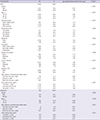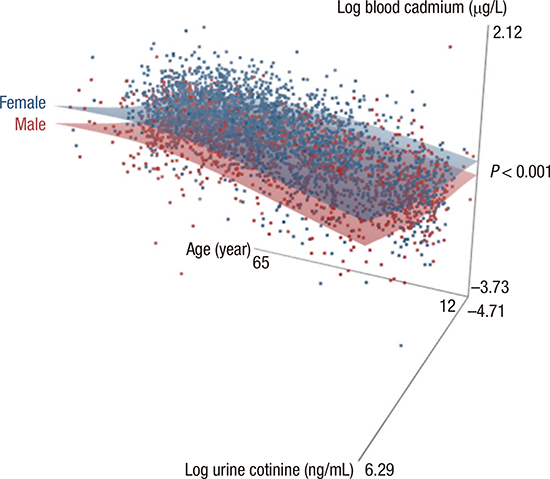2. Tyrrell J, Melzer D, Henley W, Galloway TS, Osborne NJ. Associations between socioeconomic status and environmental toxicant concentrations in adults in the USA: NHANES 2001–2010. Environ Int. 2013; 59:328–335.
3. Warren GW, Alberg AJ, Kraft AS, Cummings KM. The 2014 surgeon general’s report: “The health consequences of smoking--50 years of progress”: a paradigm shift in cancer care. Cancer. 2014; 120:1914–1916.
4. Choi S, Kim Y, Park S, Lee J, Oh K. Trends in cigarette smoking among adolescents and adults in South Korea. Epidemiol Health. 2014; 36:e2014023.
5. Yin P, Jiang CQ, Cheng KK, Lam TH, Lam KH, Miller MR, Zhang WS, Thomas GN, Adab P. Passive smoking exposure and risk of COPD among adults in China: the Guangzhou Biobank Cohort Study. Lancet. 2007; 370:751–757.
6. Yoon JH, Kim I, Kim HR, Won JU, Bae KJ, Jung PK, Roh J. The association between blood cadmium level and airflow obstruction in Korean men. Ann Hum Biol. 2015; 42:569–575.
7. Nawrot T, Plusquin M, Hogervorst J, Roels HA, Celis H, Thijs L, Vangronsveld J, Van Hecke E, Staessen JA. Environmental exposure to cadmium and risk of cancer: a prospective population-based study. Lancet Oncol. 2006; 7:119–126.
8. Peters JL, Perlstein TS, Perry MJ, McNeely E, Weuve J. Cadmium exposure in association with history of stroke and heart failure. Environ Res. 2010; 110:199–206.
9. Thompson J, Bannigan J. Cadmium: toxic effects on the reproductive system and the embryo. Reprod Toxicol. 2008; 25:304–315.
10. Talio MC, Luconi MO, Masi AN, Fernández LP. Cadmium monitoring in saliva and urine as indicator of smoking addiction. Sci Total Environ. 2010; 408:3125–3132.
11. Järup L, Berglund M, Elinder CG, Nordberg G, Vahter M. Health effects of cadmium exposure--a review of the literature and a risk estimate. Scand J Work Environ Health. 1998; 24:Suppl 1. 1–51.
12. Brockhaus A, Freier I, Ewers U, Jermann E, Dolgner R. Levels of cadmium and lead in blood in relation to smoking, sex, occupation, and other factors in an adult population of the FRG. Int Arch Occup Environ Health. 1983; 52:167–175.
13. Willers S, Schütz A, Attewell R, Skerfving S. Relation between lead and cadmium in blood and the involuntary smoking of children. Scand J Work Environ Health. 1988; 14:385–389.
14. Jung SY, Kim S, Lee K, Kim JY, Bae WK, Lee K, Han JS, Kim S. Association between secondhand smoke exposure and blood lead and cadmium concentration in community dwelling women: the fifth Korea National Health and Nutrition Examination Survey (2010–2012). BMJ Open. 2015; 5:e008218.
15. Campo L, Polledri E, Bechtold P, Gatti G, Ranzi A, Lauriola P, Goldoni CA, Bertazzi PA, Fustinoni S. Determinants of active and environmental exposure to tobacco smoke and upper reference value of urinary cotinine in not exposed individuals. Environ Res. 2016; 148:154–163.
16. Kweon S, Kim Y, Jang MJ, Kim Y, Kim K, Choi S, Chun C, Khang YH, Oh K. Data resource profile: the Korea National Health and Nutrition Examination Survey (KNHANES). Int J Epidemiol. 2014; 43:69–77.
17. Zielińska-Danch W, Wardas W, Sobczak A, Szołtysek-Bołdys I. Estimation of urinary cotinine cut-off points distinguishing non-smokers, passive and active smokers. Biomarkers. 2007; 12:484–496.
18. Park JH, Lee CK, Kim KH, Son BC, Kim JH, Suh CH, Kim SY, Yu SD, Kim SJ, Choi WH, et al. Decrease in the urine cotinine concentrations of Korean non-smokers between 2009 and 2011 following implementation of stricter smoking regulations. Int J Hyg Environ Health. 2016; 219:123–128.
19. Choi WJ, Han SH. Blood cadmium is associated with osteoporosis in obese males but not in non-obese males: the Korea National Health and Nutrition Examination Survey 2008–2011. Int J Environ Res Public Health. 2015; 12:12144–12157.
20. Lee BK, Kim Y. Association of blood cadmium with hypertension in the Korean general population: analysis of the 2008–2010 Korean National Health and Nutrition Examination Survey data. Am J Ind Med. 2012; 55:1060–1067.
21. Evans GW, Kantrowitz E. Socioeconomic status and health: the potential role of environmental risk exposure. Annu Rev Public Health. 2002; 23:303–331.
22. Kim NS, Lee BK. National estimates of blood lead, cadmium, and mercury levels in the Korean general adult population. Int Arch Occup Environ Health. 2011; 84:53–63.
23. Son JY, Lee J, Paek D, Lee JT. Blood levels of lead, cadmium, and mercury in the Korean population: results from the second Korean National Human Exposure and Bio-monitoring Examination. Environ Res. 2009; 109:738–744.
24. Figueroa BE. Are more restrictive food cadmium standards justifiable health safety measures or opportunistic barriers to trade? An answer from economics and public health. Sci Total Environ. 2008; 389:1–9.
25. Nie Z, Racine JS. The crs package: nonparametric regression splines for continuous and categorical predictors. R J. 2012; 4:48–56.
26. Benowitz NL, Kuyt F, Jacob P 3rd, Jones RT, Osman AL. Cotinine disposition and effects. Clin Pharmacol Ther. 1983; 34:604–611.
27. DeLorenze GN, Kharrazi M, Kaufman FL, Eskenazi B, Bernert JT. Exposure to environmental tobacco smoke in pregnant women: the association between self-report and serum cotinine. Environ Res. 2002; 90:21–32.
28. Arain MB, Kazi TG, Jamali MK, Jalbani N, Afridi HI, Kandhro GA, Ansari R, Sarfraz RA. Hazardous impact of toxic metals on tobacco leaves grown in contaminated soil by ultrasonic assisted pseudo-digestion: multivariate study. J Hazard Mater. 2008; 155:216–224.
29. Låg M, Rodionov D, Ovrevik J, Bakke O, Schwarze PE, Refsnes M. Cadmium-induced inflammatory responses in cells relevant for lung toxicity: expression and release of cytokines in fibroblasts, epithelial cells and macrophages. Toxicol Lett. 2010; 193:252–260.
30. Blum JL, Rosenblum LK, Grunig G, Beasley MB, Xiong JQ, Zelikoff JT. Short-term inhalation of cadmium oxide nanoparticles alters pulmonary dynamics associated with lung injury, inflammation, and repair in a mouse model. Inhal Toxicol. 2014; 26:48–58.
31. Tellez-Plaza M, Navas-Acien A, Caldwell KL, Menke A, Muntner P, Guallar E. Reduction in cadmium exposure in the United States population, 1988–2008: the contribution of declining smoking rates. Environ Health Perspect. 2012; 120:204–209.
32. Järup L, Akesson A. Current status of cadmium as an environmental health problem. Toxicol Appl Pharmacol. 2009; 238:201–208.
33. Kippler M, Ekström EC, Lönnerdal B, Goessler W, Akesson A, El Arifeen S, Persson LA, Vahter M. Influence of iron and zinc status on cadmium accumulation in Bangladeshi women. Toxicol Appl Pharmacol. 2007; 222:221–226.
34. Roth LK, Taylor HS. Risks of smoking to reproductive health: assessment of women’s knowledge. Am J Obstet Gynecol. 2001; 184:934–939.
35. Golub MS. Adolescent health and the environment. Environ Health Perspect. 2000; 108:355–362.
36. Dunphy B. Acute occupational cadmium poisoning. A critical review of the literature. J Occup Med. 1967; 9:22–26.
37. Cai S, Yue L, Shang Q, Nordberg G. Cadmium exposure among residents in an area contaminated by irrigation water in China. Bull World Health Organ. 1995; 73:359–367.







 PDF
PDF ePub
ePub Citation
Citation Print
Print





 XML Download
XML Download